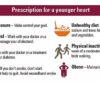Since the mid-90s, when Fosamax (alendronate) was first approved, bisphosphonates have been commonly used to effectively treat osteoporosis in millions of patients.
But bisphosphonates (the class of drugs that work to rebuild and strengthen bone tissue), which are taken either orally or as injections, are not without side effects and recently, some of the potential long-term effects of these medications, while rare, have come under scrutiny. Conversations about what those effects might or might not be and who, in fact, should be taking these drugs have been taking place in the media and medical community alike.
One issue is that no one really knows yet what the optimum length of time patients should be taking these drugs. A study by the FDA, published in the New England Journal of Medicine, caused a stir — taking on the question of whether or not continued use of bisphosphonates helps patients or might put them at increased risk for atypical fractures or other side effects.
‘In other therapies we are confident in saying the effects of the medicine are gone, once we stop giving them… Whereas with bone the exact opposite is true.’ — Kurt Kennel, MD
The study suggests that taking bisphosphonates beyond 5 years doesn’t necessarily continue to improve bone density or strength for all patients. One recommendation is that patients who were initially at low-risk for osteoporosis-related fractures would probably benefit from discontinuing the medication after 3 to 5 years, whereas those patients at a greater risk from the outset would benefit from continuing.
Browse This Article
Concern About the Unknown
“Bone is a slow-changing tissue and its metabolism is a gradual process,” says Kurt Kennel, MD, assistant professor of medicine in the Division of Endocrinology, Metabolism and Nutrition at the Mayo Clinic. “A big concern I have is the unknown. Will bone strength remain stronger like we think it does in the first years of therapy, or will it paradoxically not be as strong or healthy in the long run because we’ve manipulated it with these rather long lasting medications?”
Dr. Kennel points to the fact that there hasn’t been enough time to study the long-term residual effects of bisphosphonates simply because they haven’t been around for that long. “In other therapies we are confident in saying the effects of the medicine are gone, once we stop giving them,” he says. “So if we have reservations in terms of long-term safety we can always counter that concern with the medicine being out of the body. Whereas with bone the exact opposite is true, it has every reason to still be in the body and every reason it has some impact decades down the road.”
Short-term Side Effects
Oral Bisphosphonates (Fosamax, Boniva, Actimel, all available in generic form)
The biggest complaint is upper gastrointestinal discomfort such as nausea, abdominal pain and heartburn. Patients are encouraged to take the medication with a full glass of water and remain upright for 30 minutes to an hour after consumption.
IV Bisphosphonates (Reclast, or zoledronic acid)
It’s not uncommon for patients to experience flu-like symptoms 24 to 72 hours after receiving the infusion; typically symptoms lessen with the second and subsequent doses. This “acute phase response,” says Dr. Kennel, could occur in as few as 1in 3, but more likely it’s 50% of patients. Often, the symptoms are so minor, people don’t report them to their doctors.
Long-term Effects
Atypical Femur Fracture
This side effect, while statistically rare, has emerged as one of the primary concerns of bisphosphonate use. A typical osteoporosis fracture often happens in the hip or the neck of the femur (the long bone in the thigh). But some osteoporosis patients taking bisphosphonates end up with breaks in the middle of their femur.
While the reason is unclear, Dr. Kennel suggests that since the medicine doesn’t discriminate where in the skeleton it goes, the same dose that is appropriately strengthening the bones weakened by disease, might be too much for other locations, such as the middle of the femur which needs some flexibility for normal walking function. It’s a paradox: The drug makes the bone stronger, but may also leave it less resilient, and more prone to a stress fracture or a break.
Again, these fractures are very rare: “If you treat 1,000 women with osteoporosis with a bisphosphonate for 3 years, you’ll prevent about 100 fractures and perhaps out of those 1,000 patients, 1of them might have a atypical femur fracture,” says Michael Lewiecki, MD, director of the New Mexico Clinical Research & Osteoporosis Center, and Clinical Assistant Professor of Medicine, University of New Mexico School of Medicine. Most of the atypical femur fractures occur in patients who have taken bisphosphonates for 7 years or more, says Dr. Lewiecki.
In some cases, researchers might consider a drug holiday as an option: “After being treated for 3 to 5 years, if your fracture risk is no longer very high, you could consider stopping taking the drug, and there would presumably be enough of the medication built up in your bones that it would continue to be effective and reduce the risk of fractures for at least a year or two afterwards.” As the level of medication goes down, he explains, you’ll presumably lower your risk of an atypical fracture. That said, a bisphosphonate holiday doesn’t equal bisphosphonate retirement; when bone density decreases again and fracture risk increases, medication will be needed.
Osteonecrosis of the Jaw (ONJ)
ONJ is defined as exposed bone in the jaw that persists at least eight weeks after identification. The occurrence of ONJ among oral bisphosphonate users is quite low — 1 in 100,000 patients — according to a report published by the National Institutes of Health, with the incidence slightly higher among IV patients.
More often than not ONJ doesn’t happen spontaneously but is associated with trauma to the jaw, typically a tooth extraction, says Dr. Kennel. A patient being considered for bisphosphonate therapy who also requires dental treatment probably shouldn’t do both simultaneously. “It just doesn’t make sense to be taking the medicine and having teeth pulled when the teeth could be pulled first and start the medicine later,” says Dr. Kennel.
Atrial Fibrillation
There is some suggestion that IV bisphosphonate use in particular might contribute to increased risk of developing atrial fibrillation, a common type of heart rate problem. There tends to be an overlap in the demographic of patients who have a high risk for osteoporosis and for atrial fibrillation, says Dr. Kennel. As such, “those at high risk for atrial fibrillation might have greater reason to consider this potential adverse effect,” he says.
Esophageal Cancer
Amid some concerns, an evaluation by the NIH examined several studies and refutes direct correlation between bisphosphonate treatment and esophageal cancer.
How Bisphosphonates Work
Normal, healthy bones are constantly breaking down and building themselves back up. Cells called osteoclasts are responsible for the breaking down; osteoblasts are in charge of replacing lost cells. In fact, “all of us probably replace our skeleton about once every ten years through this process of bone remodeling,” says Dr. Lewiecki.
In post-menopausal women, and about 20% of men over age 70, that system can become unbalanced and more bone is removed than can be replaced, decreasing bone density. “The first 3 to 5 years after the onset of menopause there’s an accelerated rate of bone loss,” says Dr. Lewiecki.
With bisphosphonate treatment, the medicine is absorbed by the bone and behaves almost in a time-release fashion, slowing down the rate of bone loss, helping to increase bone density, improve the integrity of the bones and ultimately prevent osteoporosis-related fractures.
Non-Drug Ways to Build Bone
Experts seem to agree that for the average person, a multi-pronged approach to a consistent, fairly rigorous exercise regimen, might help slow down some of the effects of osteoporosis. The National Osteoporosis Foundation recommends both weight-bearing and muscle-strengthening exercises for better bone health. Exercises that improve balance are also important to prevent falls.
“The message we try to give people,” says Dr. Kennel, “is [that exercise] attenuates the changes, it doesn’t necessarily stop them. But like a lot of other things, maybe I would have the problem at 90 anyway, but by being a healthy person I won’t have it when I’m 70.”
As for diet, adequate intake of calcium and vitamin D are essential for skeletal health. Dairy products, dark green leafy vegetables, and some types of fish are all high in calcium, though there is some debate about the best options.
Many doctors recommend a vitamin D supplement, since concerns about sun exposure (our bodies make vitamin D as a result of sun hitting our unprotected skin) prevent most people from absorbing enough through the skin.
A Shift in Philosophy
When the FDA approved bisphosphonates in the ’90s, it was not just to treat but also to prevent osteoporosis in women who showed no signs of symptoms. There was little consideration then about duration of treatment or what the long-term effects might be.
“We’ve passed through that phase and now the thinking is, we want to identify those people who are high risk for fracture and treat them. And that’s a situation where we feel the benefits far outweigh the risks,” says Dr. Lewiecki.
And what about those who were treated back then? If they’re now showing symptoms of disease, did that course of medicine impact what happens today? The answers aren’t clear, suggests Dr. Kennel. “You’ve already used the medicine, so would it be safe to use again?” he asks. “Right now it’s a question of: Did it really do any good, and did it complicate what we might do when they’re in their 70s or 80s, when they might have an acute need for some sort of help or treatment,” he adds.
“The general concept with bisphosphonates is the same with all medications,” says Dr. Lewiecki. “We want to use lowest possible dose for the shortest period of time… and if we can achieve our goals for treatment with a lower dose or by giving for a lesser period of time then we’d always like to do that.”
Further Reading
- New Cautions About Long Term Use of Bone Drugs (New York Times)
- FDA Still Cautious About Bone Drugs (ABC News)
- New Data Linking Bisphosphonates and Atrial Fib: Should FDA Revisit? (Medscape)







